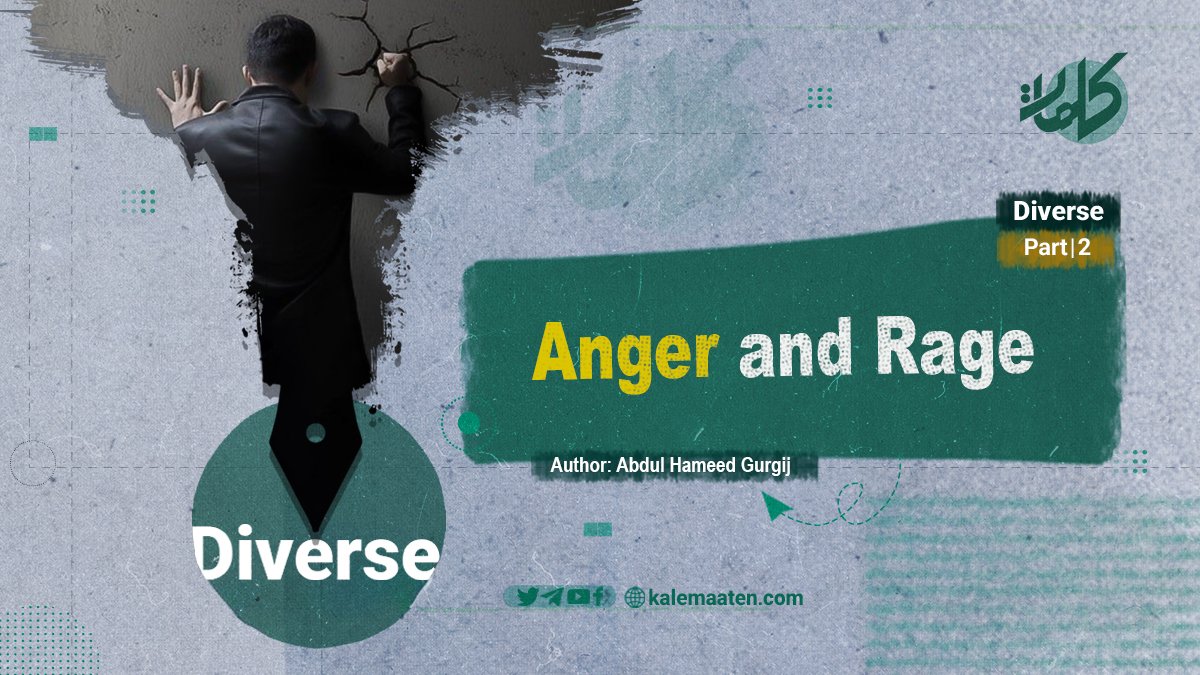
Author: Abdul Hameed Gurgij
Anger and Rage (Part Two)
Anger and Rage:
Imam Muhammad al-Ghazali (MABH), in Ihya Ulum al-Din, discusses anger and rage alongside resentment, envy, and jealousy. He explains that anger and rage are the primary causes of resentment and envy, which are two extremely dangerous and destructive diseases affecting both individuals and society. While anger can give rise to many other harmful emotions, their severity does not reach the level of these two.
It is important to note that there exists a type of anger and rage that neither piety nor moral principles can restrain. This means that a person cannot control themselves out of fear of God or in pursuit of His pleasure and reward. Such anger is profoundly unhealthy and has dire consequences, leading to destruction without boundaries. This is especially true when an angry person possesses substantial wealth, worldly status, or both, enabling them to oppress others to demonstrate their power—ultimately resulting in the humiliation and destruction of those around them.
Undoubtedly, our era is filled with individuals who become enraged due to corrupt ideologies and unbalanced personalities. They have established exile camps, prisons, and detention centers for those who oppose them, setting up gallows and execution platforms for anyone who does not fully align with their views. They have inflicted sorrow, grief, pain, and suffering into every household, mercilessly oppressing anyone who values dignity, freedom, and honor. If one could board an aircraft, soar to the highest possible altitude, and observe the earth through a telescope, they would see human blood spilled almost as frequently as the blood of slaughtered animals. Undoubtedly, the root cause of this is anger, rage, and the resentment and envy that stem from them.
It is evident that, in many cases, the primary factor fueling anger and rage is the dominance and arrogance of the wealthy and powerful elite, who wield iron and fire through weapons and clubs—whether in the East or the West—to subjugate and exploit humanity. Even a puppet ruler living outside his homeland lashes out in anger against his own people, while his oppressed compatriots endure the wounds of degradation without the ability to express their own anger.
This precisely aligns with what Imam Muhammad al-Ghazali (MABH) stated in Ihya Ulum al-Din: “Indeed, anger and rage are flames of fire that burn within the hearts of cruel and arrogant individuals. It is like a smoldering ember beneath the ashes, waiting to be ignited by arrogance and self-conceit in the hearts of every tyrant and self-righteous oppressor.”
Anger is a natural phenomenon found in all humans and even in animals. In certain situations, it is necessary and justified. For instance, if a person is attacked, if their wealth and honor are threatened, or if their family and protector are harmed, it is natural for them to become angry and take action within their capacity to defend themselves. Such anger is not only acceptable but sometimes obligatory.
Thus, every Muslim should ensure that when they experience anger in such situations, they respond within the limits of religious teachings and the principles of justice and fairness associated with their faith. However, if someone becomes angry simply due to a lack of respect, being overlooked, or an inability to oppress others as they wish, such anger arises from the prejudices of ignorance and a demonic sense of arrogance and selfishness. It constitutes an outright crime against humanity.
No one has wronged this person to warrant their anger. Moreover, human beings are not ignorant creatures like animals, to be forcibly placed under the authority of a specific individual without their consent. They are not to be governed blindly, allowing a ruler to indulge in his desires and whims. As previously mentioned, much of the suffering plaguing human society today is a direct consequence of unrestrained and irrational anger.
The Difference Between Anger and Aggression
Aggression differs from anger. Anger is a natural emotion, whereas aggression is a form of behavior. A person’s anger may not be visible to others, but aggressive behavior is observable. When anger is expressed through behavior, it is classified as aggression. Aggression negatively affects a person’s quality of life, relationships, and overall well-being.
If anger is not managed properly, it can transform into aggression, which has detrimental effects on mental health. Over time, anger can lead to hostility, manifesting in feelings of hatred, jealousy, humiliation, and rage. Hostility is a persistent emotion that may last for an extended period and can arise in various situations.
Aggression is an external expression of anger that can be demonstrated behaviorally, either verbally or non-verbally. Verbal aggression includes actions such as insulting and yelling, while non-verbal aggression manifests through behaviors like harming others, damaging property, or mistreating animals. Anger can also lead to physical changes, such as an increased heart rate, flushed skin, tension, and tight muscles.
From a psychological perspective, anger is linked to an individual’s internal thoughts and self-dialogues about themselves, others, and their surroundings. It functions as an unconscious psychological defense mechanism.
Continues…


